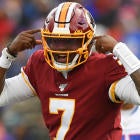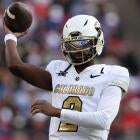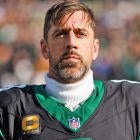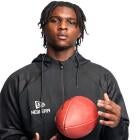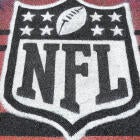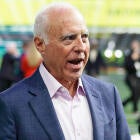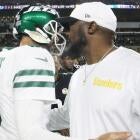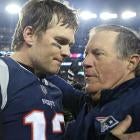More and more in recent seasons, it's become clear that the most important thing in the modern NFL is offensive infrastructure. Offense has been more important than defense for a while now, and the personnel involved in crafting that offense matters a great deal when it comes to determining its success.
Who is your quarterback? Who is protecting him? Who does he throw to? Who does he have next to him in the backfield? Who's scheming those players open? All the pieces matter. The degree to which they matter varies greatly, of course, but each plays a role in making an offense hum at peak efficiency.
All of this brings us to the following project: ranking the offensive infrastructure of all 32 NFL teams. To go about this, we used a weighted grading system where each team was given a 1-5 ranking (1 = terrible, 5 = elite) in the following areas: Quarterback, Offensive Line, Pass-Catchers (WR/TE), Running Backs, and Play-Caller (head coach or offensive coordinator).
Those scores were then weighted so that quarterback was the most important component of the offense, followed by offensive line, play-caller, pass-catchers, and then finally running backs, so that the weights reflected as closely as possible the reality of the way modern NFL offenses really work. We'll run through these rankings in this space over the next few days, beginning below with the lowest-ranking tier in the NFL.
Why can't Cam Newton and Jameis Winston find starting gigs? Brady Quinn joins Will Brinson to break down the odd offseason QB market and much more; listen below and be sure to subscribe for daily NFL goodness.
32. Washington Redskins (2.13)
Grades: QB: 2. OL: 3. Play-caller: 2. WR/TE: 1. RB: 2. Total: 10.
It would be fair to say that Dwayne Haskins struggled in his debut season. In seven starts, Haskins completed only 58.8 percent of his passes at an average of 6.7 yards per attempt. Each of those figures was considerably below the league average. The same was true of Haskins' touchdown and interception rates, his passer rate, and his QBR. He took sacks far more often than the average quarterback, and according to Pro Football Reference he had a sky-high bad throw rate of 19.4 percent.
He looked far better in his final two starts of the year (31 of 43 for 394 yards, four touchdowns, zero interceptions, three sacks) but they came against the putrid pass defenses of the division rival Giants and Eagles. It's difficult to put much stock in Haskins' 203-pass sample from his rookie season, but it's even more difficult to put much stock in a far smaller 43-pass sample size. So, heading into his second season, Haskins was given a below-average grade.
We did not include Trent Williams as part of Miami's offensive line given his steadfast refusal to report to the team, but with a new training staff hopefully keeping this unit healthier than it has been in the past, the presence of Brandon Scherff, Chase Roullier, and Morgan Moses was enough to give the line an average grade here. Offensive coordinator and presumptive play-caller Scott Turner is well-respected and also the son of one of the premier offensive minds of the 1990s and early 2000s (Norv Turner) but did not exactly impress in his first run down the stretch of the 2019 season with the Panthers. It's too early to make much of a call on him either way.
Even after landing a steal with Terry McLaurin in the third round of last year's draft, Washington desperately needs to upgrade the pass-catching corps that Haskins has to work with. Steven Sims, Trey Quinn, Kelvin Harmon, Jeremy Sprinkle ... this is not an inspiring group, to say the least. It was one of the lowest-graded units in this entire exercise. Similarly, the team's running back room is an issue. Adrian Peterson is an adequate rusher, but he provides next to nothing as a pass-catcher. Derrius Guice has to prove he can stay healthy before he even comes into consideration. And Bryce Love is coming off of a serious injury of his own. Upgrading the weaponry for Haskins looks like a serious, long-term project.
31. Miami Dolphins (2.47)
Grades: QB: 3. OL: 2. Play-caller: 3. WR/TE: 2. RB: 1. Total: 11.
The Dolphins were one of the tougher teams to rank. There is a widespread expectation that they'll select Tua Tagovailoa or Justin Herbert with the No. 5 overall pick, or trade up to No. 2 or 3 to land their preferred guy. But we don't know which of them it will be -- or even if they'll end up picking one of them at all, since they could get leapfrogged by a team like the Chargers for the player they prefer and then instead elect to use the pick on a non-quarterback. So, you're left with Ryan Fitzpatrick as the quarterback part of the equation. Fitz is fine if you want to be an entertainingly bad team, which is exactly what the late-season Dolphins were last year, but he's not getting an above-average grade.
Miami spent a bunch of money to upgrade its offensive line this offseason -- a necessary expenditure given how porous the unit was last season. But bringing in Ereck Flowers on a double-digit million dollar per-year deal is not exactly what people probably had in mind, even if last season was the best of his career so far. Similarly, Ted Karras is a fine option at center, but it's probably not a coincidence that New England's offense struggled while he replaced David Andrews in the pivot. He's serviceable, which is an improvement for the Dolphins, but again, this is still a below-average unit in need of several talent and depth upgrades.
Chan Gailey is the team's new play-caller, which is a strange development. Chad O'Shea's offense picked up down the stretch of the season, but the team decided to let him go and bring back a guy who has been retired since 2016. What was Gailey doing before that? Coordinating the Fitzpatrick-led 2015 and 2016 Jets. Fitz had a flukily solid year in 2015 when he threw 31 touchdowns against only 15 picks but benefitted from a ton of dropped interceptions. In four years since, he's gone back to being the same guy. Perhaps Gailey can recapture that magic, but it seems quite unlikely. And it's not as though he dramatically raised the ceiling of his offenses prior to that 2015 Jets season.
DeVante Parker's breakout season helps the pass-catching unit's grade, as does the early-season emergence of Preston Williams as a solid target. Albert Wilson getting back on the field should help, and Mike Gesicki becoming at least somewhat reliable should, too. But Parker still seems a bit untrustworthy, while Williams doesn't have much of a track record and Wilson doesn't, either. All around, it's a below-average unit. And the Jordan Howard-Kalen Ballage combination out of the backfield is the least threatening duo in the league at the moment.
T-28. Cincinnati Bengals (2.60)
Grades: QB: 3. OL: 2. Play-caller: 2. WR/TE: 3. RB: 4. Total: 14.
Unlike with the Dolphins, we can make some pretty strong assumptions regarding who will be under center for the Bengals in 2020. It's not going to be Andy Dalton. It's going to be Joe Burrow. Perhaps in another world Tagovailoa would have been the No. 1 overall pick, but Burrow's sparkling 2019 season, Tagovailoa's hip injury, and the coronavirus-interrupted pre-draft season all conspire to make sure Burrow is the selection. He is coming off of arguably the greatest college football season of all time, and gives the Bengals significant hope for the future.
That said, most rookie quarterbacks are not good -- even guys who go on to become superstars. So, we shouldn't expect Burrow to be elite right out of the gate. Even average is probably aggressive, but that's how we graded him here. The unit around him is lacking in pretty much all areas, though.
The Cincinnati offensive line was a bit of a train wreck last season, ranking 31st in the NFL in ESPN's Pass Block Win Rate metric. They should have 2019 first-rounder Jonah Williams on the field this season, though, which should at least provide a bit of a boost after he missed all of last year due to injury. Signing Xavier Su'a-Filo away from the Cowboys on a below-market deal was a nice bit of business as well. But the rest of the line still needs work.
Joe Mixon and Gio Bernard are a strong one-two punch out of the backfield, and they both have the ability to make plays in the passing game. That should help Burrow as he transitions to the NFL. How you feel about his pass-catchers likely depends on whether or not you think A.J. Green will actually ever play for the Bengals again. I personally do not, but our resident Bengals fan John Breech convinced me to include him in these rankings so the team got a slight bump there.
There remain questions about head coach and play-caller Zac Taylor after an extremely uninspiring debut season. The shine is off the Sean McVay coaching tree a bit after last year, and it remains to be seen what Taylor and offensive coordinator Brian Callahan actually bring to the table.
T-28. New York Jets (2.60)
Grades: QB: 3. OL: 3. Play-caller: 2. WR/TE: 1. RB: 4. Total: 13.
Sam Darnold had a season to forget in 2019. He struggled in his debut and then missed several weeks due to mononucleosis. He returned to the field and lit up the Cowboys, then saw ghosts against the Patriots in one of the worst prime-time performances we've seen from a quarterback in quite some time. He ended the year having progressed only slightly from the year before rather than taking the massive leap forward many expected from him in Year 2. Heading into his third season, the Jets have made efforts to upgrade the infrastructure around him in some areas (offensive line) but have notably not done so in others (pass-catchers).
The most important thing New York did this offseason was go shopping for offensive linemen. The choice of George Fant as part of that shopping spree was an odd one, but Connor McGovern and Greg Van Roten should help keep Darnold more well-protected than he's been for most of the past two seasons.
Letting Robby Anderson walk for the cheap contract he got from the Panthers (two years, $20 million) seems like a mistake, especially when you consider that he was by far the team's best big-play threat. Replacing him with Breshad Perriman for a smaller, shorter deal (one year, $6 million) seems like a fine trade-off on the surface, but Perriman has essentially a five-game track record of being a useful NFL player in his four-year career. Anderson has been somewhat unreliable off the field, but he's more dependable on it than Perriman. Jamison Crowder enjoyed incredible volume last season as Darnold and his illness-replacements repeatedly checked down while under pressure, but he's never been much of a big-play threat. Quincy Enunwa has suffered repeated injuries over the years and can't necessarily be counted on. The Chris Herndon breakout was delayed a year, but he and Darnold have good chemistry and he's a terrific athlete.
Le'Veon Bell returned from his yearlong absence looking like mostly the same player he was during his final season in Pittsburgh, but that player was not a strong fit for New York's disaster of an offensive line, which couldn't hold blocks long enough to allow Bell to do his usual dance behind the line of scrimmage before finding a lane. The result was a career-low 3.2 yards per carry average and a 42 percent success rate that ranked 40th out of 45 qualifiers at Football Outsiders. He was not much helped by Adam Gase, and neither was Darnold. It doesn't look great for Gase that players like DeVante Parker and Kenyan Drake had delayed breakouts after they got out of his offense, nor that Jarvis Landry looked like a far more useful player once his team allowed him to actually test defenses downfield.
T-28. New York Giants (2.60)
Grades: QB: 2. OL: 3. Play-caller: 2. WR/TE: 3. RB: 5. Total: 15.
The Giants appear to have upgraded at quarterback by replacing the aging version of Eli Manning with Daniel Jones, who is far more athletic and capable of making big plays. Jones still has plenty of issues to iron out when it comes to ball security, decision-making, and accuracy, but at least having the threat of making big plays through the air along the ability to escape the pocket and take off downfield has the Giants in a better position at the game's most important position than they were this time last year.
The offensive line is still not necessarily a true positive, but it is not nearly the disaster it was as recently as a couple years ago. Nate Solder was an overpay, but he's an acceptable starter at left tackle. Kevin Zeitler is one of the best guards in the league. Will Hernandez looks like a solid, if relatively unspectacular draft pick. Trading Odell Beckham Jr. sapped the offense of some of its big-play capabilities, but the emergence of Darius Slayton alongside Sterling Shepard and Golden Tate gives New York a pretty solid wide receiver corps. If they hang onto Evan Engram and manage to keep him healthy for once, Jones has a lot to work with there, even if Shepard and Tate are a bit redundant and there's not much in the way of depth behind them or Engram.
The Giants also have a dynamic threat out of the backfield in Saquon Barkley, who we gave an elite grade despite his injury-marred second season. Barkley is never going to be the most consistent runner simply due to his style, but he is a scoring threat from everywhere on the field and a very capable pass-catcher. Jones did not check down to his running backs all that often last season but when he does in the future, he'll have a more threatening player to whom he can get the ball than he did for most of his rookie year.
The Giants, though, brought in Jason Garrett to be their offensive coordinator, and to presumably call the plays. Garrett has not called played in eight years, and the last time he did, he failed to coax a top-10 offense out of a unit that included Tony Romo, DeMarco Murray, Terrell Owens, Miles Austin, and Jason Witten. He would not be an inspiring choice even if he weren't also one of the most risk-averse coaches in the league, and one who still believes in the outdated maxim that the way to win in the NFL is by running the ball and stopping the run.
27. Denver Broncos (2.73)
Grades: QB: 2. OL: 3. Play-caller: 3. WR/TE: 3. RB: 4. Total: 15.
Drew Lock got off to a surprisingly spectacular start to his career, but cooled down considerably over the final three games of the year. He certainly has the traits John Elway seems to look for in a quarterback, with prototype size and a cannon for an arm. We still have to see whether he has the accuracy and decision-making to become the quarterback the Broncos want him to be, and it's tough to draw any conclusions after 156 rookie-season passes.
Much like many other teams on this list, the Broncos have some issues along the offensive line, which should only be exacerbated after they let McGovern leave for the Jets. Signing Graham Glasgow to replace him seems like finding a solution to a problem that didn't really exist. They also probably need to replace Garrett Bolles on the left side of the line, which is an issue since he was only recently a first-round pick.
Courtland Sutton's breakout second season was a great sign for the team's future, but the pass-catching cupboard beyond him is somewhat bare. Noah Fant has a lot of talent and needs to get more snaps. He's a freak of an athlete and should be a big help to Lock as his career develops. And that's about it when it comes to quality pass-catching options here. DaeSean Hamilton, Tim Patrick, Jeff Heuermann ... any of these guys scare you? No? Me, neither.
The Broncos were perfectly fine at running back with Phillip Lindsay and Royce Freeman, but for some reason splashed the pot to sign Melvin Gordon. It probably doesn't matter that much. They also brought in Pat Shurmur to coordinate the offense, but that's been a hit-or-miss situation over the years.
![[object Object] Logo](https://sportshub.cbsistatic.com/i/2020/04/22/e9ceb731-8b3f-4c60-98fe-090ab66a2997/screen-shot-2020-04-22-at-11-04-56-am.png)








